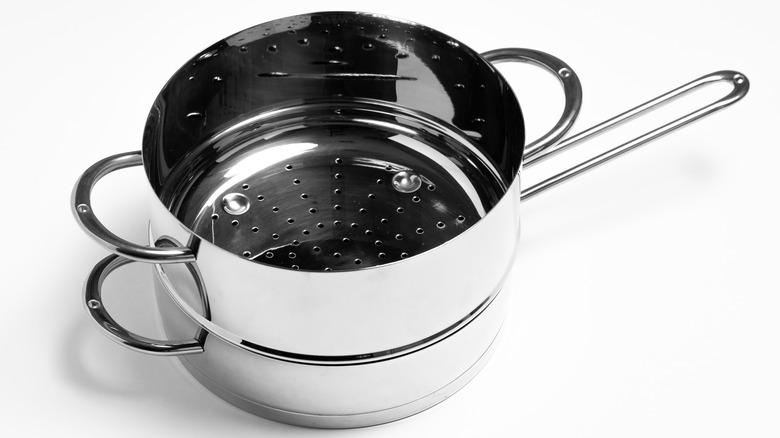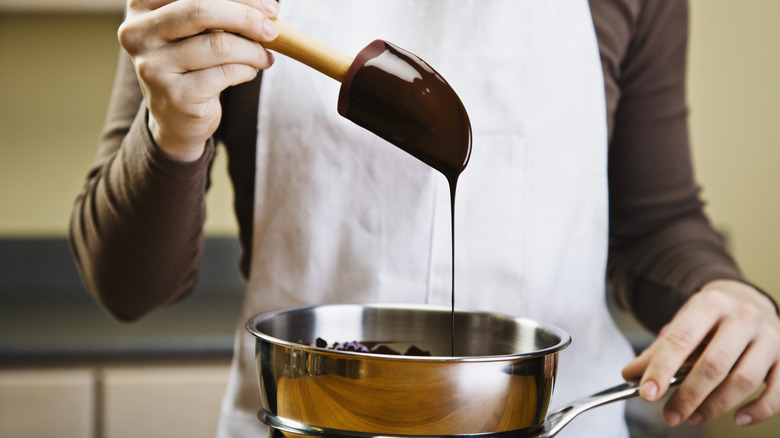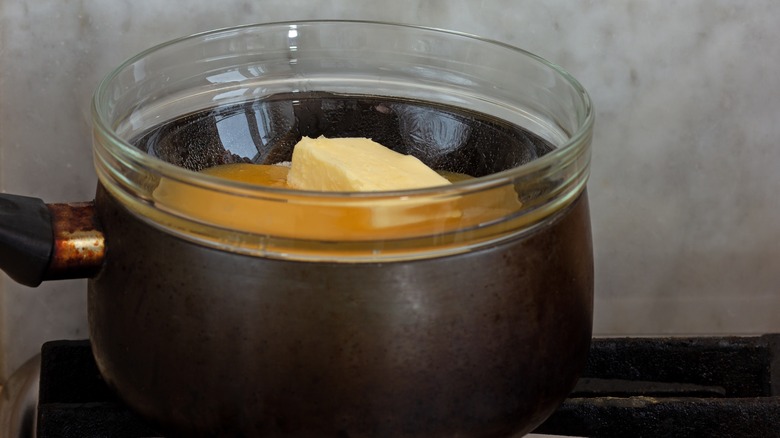What Is A Double Boiler And When Should You Use One?
We may receive a commission on purchases made from links.
If you're an avid home cook who is always exploring new ingredients and techniques, you're likely to come across a recipe that calls for the use of a double boiler. This kitchen instrument most commonly comes up in recipes for sweet treats like custards and puddings. Many cookbooks throw the term around as if it's common knowledge, but a double boiler is a unique item that you're only likely to learn about if you're cooking very specific dishes. Perhaps that's why you're reading this right now. If so, you'll be happy to know that a double boiler is much simpler than you might imagine.
A double boiler is a two-part device that allows you to cook things over indirect heat (via MasterClass). It consists of two pots stacked atop one another (alternatively, you may place a heatproof bowl on top of a pot). The bottom pot is filled with water and placed on the stove until the water reaches a steady simmer. The top pot or bowl sits just above the water line, absorbing heat from the steam that builds up in the lower pot. All the actual cooking happens in the top pot, keeping the ingredients at a very low temperature. You might think this sounds like a lot of extra hassle when you could just put something in a pot over low heat, but there's a key difference between direct and indirect cooking.
When to use a double boiler
When you use a regular pot, the ingredients are placed in near-direct contact with the heat source, separated only by the thin bottom of your cooking vessel. A double boiler creates a more substantial barrier between the heat source and whatever you are cooking, which better moderates that temperature. Cook's Info points out that, because the top pot of a double boiler is heated by the steam given off from the bottom pot, its temperature can never exceed the boiling point of water. This makes a double boiler ideal, and often essential, for cooking items that are very sensitive to heat.
A classic use of the double boiler is for tempering chocolate, a necessary step for making many confections that involve melting chocolate. As Ghirardelli explains, chocolate is extremely heat-sensitive, scorching easily. If you've ever had to deal with the mess of a chocolate candy melting in your pocket, you can imagine how quickly the stuff will burn if you place it over the direct heat of a stove. Double boilers are also great when you need to cook an emulsified sauce. Per Food52, emulsions combine fat and water, which can only be done by breaking the fat into tiny particles that will remain suspended in the water. Too much heat can break the suspension and cause the fat to separate into a greasy mess. MasterClass lists custards and hollandaise sauce as examples of emulsions that benefit from using a double boiler.
How to make a double boiler
If you want to make one of the aforementioned items, like hollandaise or chocolate-coated candy, you have two options from which to choose. You can purchase a double boiler from a cooking supply store. Per MasterClass, these sets consist of two pots, typically made from stainless steel, that stack on top of each other. The top pot nestles neatly within the bottom pot, leaving ample space for water. However, high-quality cookware does not come cheap, and unless you want to become a chocolatier, it makes little sense to splurge on an item you'll only use occasionally. Fortunately, it's easy to make a double boiler from supplies you already have in your kitchen.
Bon Appétit explains that you only need two items to build your own double boiler: a regular pot, and a heatproof bowl (either metal or glass). The bowl must be large enough to sit on top of the pot without falling in. To turn these items into a functional double boiler, add an inch or two of water to the pot and bring it to a steady simmer. Boiling it could generate too much heat, so keep the temperature low. Place the bowl on top of the pot, making sure the bottom does not touch the water. That's all it takes! You've now got a working double boiler at your service.


